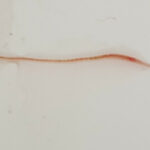Vermicomposting is the process of using worms to recycle organic material and food scraps into a useful soil amendment called “vermicompost.” As worms consume food scraps, the material becomes compost as it passes though the worms body and exits through its tail. The result is a powerful fertilizer that can be used to help grow plants to their maximum potential. Worm compost is such a powerful fertilizer mainly because worms tend to eat nutrient packed fruit and vegetable scraps and their bodies turn the scraps into nutrient-rich compost.
To begin the vermicomposting process, you will need several items including:
·Raw fruits and vegetables
·A shallow container (24″ X 18″ X 8″ should suffice) with a lid (make sure there are holes in the bottom
·Moist Leaves
· Worms: red worms, such as Eisenia foetida or
other surface feeding worms. Do not use earth worms. They will not survive in a worm composting system
After (not before) your worm bed is complete, purchase your red worms. Two pounds, which is equal to around 2,000 worms, should suffice. Red worms can be purchased from a number of online retailers or at most plant and pet stores. To start the worm bin, wash out the container or bin that you are using. Make sure there are holes in the bottom for water to drain. If the liquid doesn’t drain, a worm bin will most likely go anaerobic and the worms may possibly drown. Managing moisture in the bin is important.
Mix the organic materials together and add the worms. Worms should be fed periodically — not all at once. Too much food at one time will attract nuisance bugs, maybe animals too, and will probably start to smell after a short while. There are different methods for managing bins to keep pests like fruit flies under control. Temperature control is important. Heat will destroy your worms. Freezing cold will kill your worms, but the egg cases will survive. A plastic bin should never be put in the sun.
It takes roughly 3-5 months for the worms to eat through the materials. At this time, you will notice very little materials and a hefty amount of compost. Once this happens, it’s time to harvest.
Harvesting means — do not add any food to the bin for two weeks. When two weeks has passed, simply move all of the worm bin contents to one side of the bin and remove any large pieces of undecomposed materials. Add fresh materials – leaves, fruits and vegetables, to the empty side of the bin. Over the next two weeks or so, the worms will begin to move to the side where the new materials are located, leaving their compost behind. All that is needed at this point is to remove the old compost and replace it with fresh materials. Cover the new side of the composting bin to encourage the worms to migrate to the new side.
When you are ready to use your fresh worm compost, you can use several methods of extraction, but one method in particular seems to be the most effective. Dump the entire contents of the bin onto a large sheet of plastic and make several piles. Once exposed to the light, the worms will quickly bury themselves in the bottom of the compost within 2-3 minutes. After a few minutes, remove the top layer of compost, leaving the worms on the bottom. Once you have removed all of the worm compost, simply collect the worms and return them to the composting bin.
Worm compost material is ready to use immediately or if you choose, you can store it for later use. Worm compost can be added directly into your potting soil or mixed in with your garden soil as a soil amendment. If you notice a worm or two in the compost, don’t be alarmed. This is fairly common. Worm compost use is not limited to outdoor gardening. You can also use worm compost in the tops of your indoor plants. And don’t worry, the odor is not offensive.
Want more vermicomposting tips? Visit: wormwoman.com.
All About Worms is always free, always reader-supported. Your tips via CashApp, Venmo, or Paypal are appreciated! Receipts will come from ISIPP Publishing.














